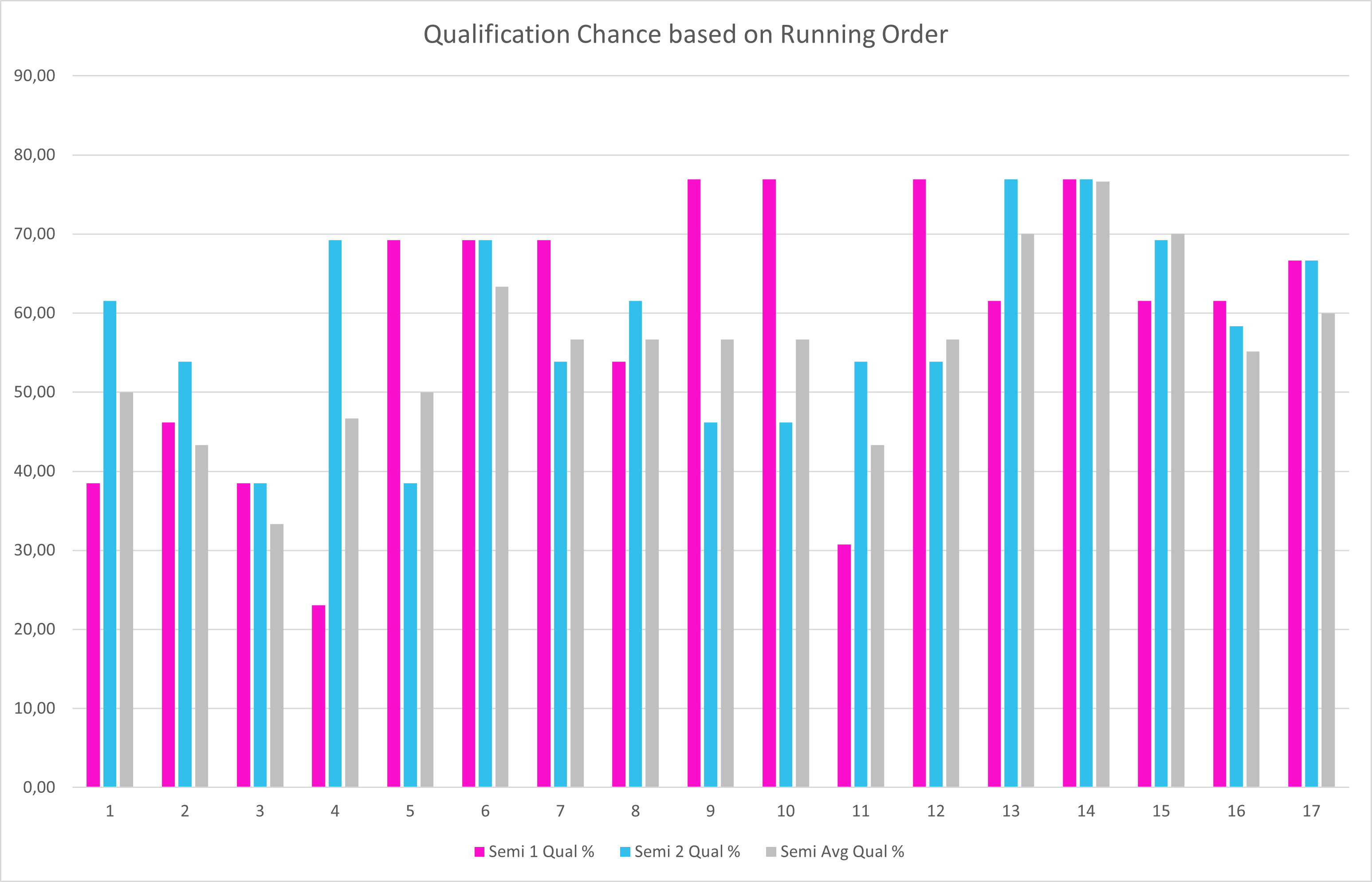As of today nobody has found a bullet proof formula to win the Eurovision Song Contest. The song, the performance and the staging are the most obvious success criteria, but we all know that this time of year another criterion is what we are all talking about – the running order. A starting position at the end of the event is thought to be a guaranteed qualification, while starting in the first half is held to be unfavorable.
You can read all the entries in the 2021 Statistics series here
The numbers
But what do the numbers actually say? Looking at the success rate of starting positions is not so straight forward. From 2004 to 2007 the competition only had a single Semi-Final, which is skewing the data a bit. If we assume that starting in the last positions is favorable, then it matters for the statistics whether there were 26 or 18 entries. Further complicating matters is that there is a variable number of entries per year even after the dual semi finals were introduced.
The changes in the voting system in 2008 and 2009 have also biased the qualifications stats on some starting positions. For these 2 years only top 9 in the Tele Vote was guaranteed a spot in the Grand Final, while the last country to qualify was decided by the back-up juries.
In 2008, Sweden (R/O* 2) qualified at the expense of FYR Macedonia (R/O 18) in the Second Semi-Final. In 2009 Finland (R/O 15) qualified at the expense of FYR Macedonia (R/O 13) in First Semi-Final and Croatia (R/O 1) qualified at the expense of Serbia (R/O 4) in the Second Semi-Final. As a consequence starting in position 15 in the First Semi-Final and position 1 and 2 in the Second Semi-Final has benefited from an artificial boost in the statistics.
The First Semi-Final vs. The Second Semi Final
Surprisingly there is a tremendous yet inexplicable difference between the success rate of a position, depending on whether it is in the First Semi-Final or the Second Semi-Final.
Below is a chart of starting positions and their respective success rate for semi finals. The grey bars are the overall success rate for all semi finals (including from the years where Eurovision only had a single semi-final), while the pink represents the running order’s chance in the First Semi-Final, and the turquoise represents the qualification chance for the Second Semi-Final.
Position 2 in the running order is often called the “draw of death”. However the statistics of the semi finals tell another story. In the First Semi-Final position 1, 3, 4 and 11 all have lower qualification rates than position 2 and overall position 3 is the actual draw of death, while position 2 and 11 are tied for second worst at 43%. Well 43% is still almost half you might say. True, but most Eurovision semi finals have fewer than 20 entries, meaning just flipping a coin to determine if an entry qualifies would yield better odds than 43%. For reference, the coin flip odds for the First Semi-Final in 2021 would be 62.5% (10/16*100)

It is generally better to start in the second half of a semi-final, especially if your entry is at the very end of the show. Not shown in the graphic above are the statistics for positions that were performed last or second to last in their shows.
If we look at all semi finals since 2004 and the rankings of songs performed in the last position and second to last, they have a 81% and 73% qualification rate respectively.
On the other hand starting in the first half is not quite so bad, with some of the positions outranking many of the ones in the second half.
Obviously if starting position were all that mattered we would be seeing 100% and 0% bars. Starting position is only part of the puzzle.
The Eurovision Song Contest isn’t a position lottery, it’s a song contest. There is clearly more to it. Maybe a favorable starting position can help push a mediocre song into the 10 qualifiers, and an unfavorable position can help deny a mediocre song qualification. On the other hand a strong entry is going to qualify regardless of starting position.
Predicted Qualifiers according to Running Order
Leaving out everything else, with the data for running orders we can try to predict some qualifiers. In the first semi final 62.5% will qualify, since there are 16 entries and 10 of those go on to the final.
Going by the running order statistics for semi final 1 alone, we can expect the following countries to qualify:
| Country | Qualification Chance |
|---|---|
| Israel | 76,9% |
| Azerbaijan | 76,9% |
| Norway | 76,9% |
| Croatia | 76,9% |
| Australia | 69,2% |
| North Macedonia | 69,2% |
| Ireland | 69,2% |
| Ukraine | 61,5% |
| Romania | 61,5% |
| Malta | 61,5% |
Cyprus misses out on qualification based on the Running Order statistics alone, ending at a mere 53.8% qualifcation chance.
I’m not entirely sure we can rely on the statistics for running order alone to predict the results of the first semi final. A real statistician might even point out that the sample size is way too small to say anything useful based on the data. It’s fun though.
Qualification percentage
| Country | R/O | Overall % | Semi 1 % |
|---|---|---|---|
 | 1 | 50 % | 38 % |
 | 2 | 43 % | 46 % |
 | 3 | 33 % | 38 % |
 | 4 | 47 % | 23 % |
 | 5 | 50 % | 69 % |
 | 6 | 63 % | 69 % |
 | 7 | 57 % | 69 % |
 | 8 | 57 % | 54 % |
 | 9 | 57 % | 77 % |
 | 10 | 57 % | 77 % |
 | 11 | 43 % | 31 % |
 | 12 | 57 % | 77 % |
 | 13 | 70 % | 62 % |
 | 14 | 77 % | 77 % |
 | 15 | 70 % | 62 % |
 | 16 | 55 % | 62 % |
| These countries may vote |
|---|
                   |
* R/O=Running Order





